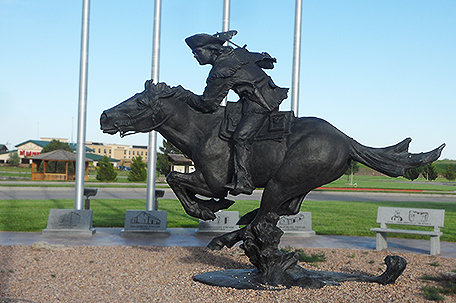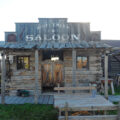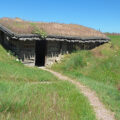
ABOVE PHOTO: Pony Express Statue
By Renée S. Gordon
“A very great vision is needed and the man who has it must follow it as the eagle seeks the deepest blue of the sky.” –Crazy Horse
A journey through modern Western Nebraska is a trip through a landscape where as William Faulkner said, “The past is never dead. It’s not even past.” Here the present and the past coexist everywhere you go and to travel its roads is to immerse yourself in western history.
More than 10,000 years ago the first inhabitants of what is now Nebraska were prehistoric Native Americans who hunted game across the plains. Eventually the Indians began to establish villages sustained by crops they raised. Interestingly, archeologist believe that the prehistoric tribes abandoned this region around 1400 AD and did not begin to return until 200-years later. The cause of this migration remains a mystery.
Horses had not existed in North America for at least 9,000-years but they were domesticated in Europe more than 2500-years ago. The first Spanish conquistadors reintroduced them to the continent and they became prized possessions of the Plains Indians about 1650. The ownership of horses drastically altered the culture and lifestyle of the natives, some tribes even becoming semi-nomadic.
When the first nonindigenous explorers, traders and trappers entered the region in the 1700s they were met by the Arapaho, Cheyenne, Ioway, Omaha, Otoe, Pawnee, Ponca and Sioux. It is generally accepted that in 1739 the French Canadians Pierre and Paul Mallet and a group of seven men were the first to traverse the entire Great Plains but Étienne Veniard de Bourgmont preceded them into the Nebraska territory in 1714. Bourgmont is credited with naming the state. When he first reached the Platte River he gave it the Otoe name “Nebrathka”, meaning, “flat water.”
Lewis and Clark mapped a portion of Nebraska in 1804 during their expedition to explore land acquired as part of the Louisiana Purchase. Zebulon Pike followed two years later to survey portions of the region and six years later Manuel Lisa erected a trading post for the St. Louis Missouri Fur Company and from that time onward Nebraska became a region of transit for pioneers, traders, mountain men and gold seekers as they joined the quest for a better life, fortune and religious freedom in the West.
The major northern overland routes all crossed Nebraska, as did the transcontinental railroad and the Pony Express, and for those reasons it presents a microcosm of the history of the western movement in the United States. The earliest routes paralleled Indian trails and these grew into the Oregon, California, Mormon and Texas-Ogallala Cattle Trails. It is estimated that more than 300,000 people crossed the Great Plains on these Trails. The story of this great multicultural movement is told through the eyes of, not just traditional males of European descent, but also of African Americans, cowboys, soldiers and women. Available online are nine brochures that provide maps and information on individual trails.
“Old Sidney Town” entered Nebraska history in 1867, relatively late, but with a bang. The town was established as a terminus for the Union Pacific Railroad and named after Sidney Dillon, the president of the railroad. At first Sidney was a surveyor’s camp, then a construction camp and finally a rail depot. The railroad requested protection from Indian attacks and the Sidney Barracks was established. The California Trail brought wagon trains near the town and when the Sidney to Deadwood Stage began to bring gold prospectors, on their way to California, into the town in the 1870s this rough and ready pot was ready to be stirred. www.sidneycheyennecountytourism.com.
Sidney rapidly became known as “Sinful Sidney” and some historians credit it with being worse than Tombstone. During its heyday this small town had nearly 100-licensed liquor establishments within a six block area and Butch Cassidy owned a livery stable. They all came through Sidney, Wild Bill, Sitting Bull, Presidents Hayes and Arthur, General Sheridan, Calamity Jane and even Susan B. Anthony.
“Outlaws, gangs and just plain thieves” began to rule the town and crime reached alarming rates. Lynchings became a viable way to solve the problem and the “good” citizens would string the miscreants up on telegraph poles within sight of Union Pacific passengers. Finally, the town was compelled to clean up its act when the railroad issued an order in 1877 that declared all passengers should be locked on the train for the duration of the train’s stop at the Sidney Station for their protection. This order had a huge adverse economic impact and forced Sidney to change.
Sidney’s African Americans numbered 10 percent of the population and records attest to their full integration into the community. Blacks founded the first church in town. One of the most interesting cases is that of a “colored” man, Charles Brown, having a shoot-out with a white man, Sam Smith in 1876. Smith was arrested based on a complaint sworn out by Brown.
Just as early travelers were outfitted in the Western Nebraska trading posts and mercantile stores of the day, contemporary travelers can fill their lists of camping gear at the World’s Foremost Outfitter of fishing, hunting, and outdoor gear. Cabela’s has been family-owned from its beginning in 1961 when Dick Cabela purchased fishing flies at a furniture show and sold them from his home. The first showroom opened in 1991 and today there are 57 stores and a large online presence. Each store focuses on regional products and is designed to be a family experience with in-store events, promotions, and lessons. Cabela’s is also a leader in the creation of innovative products. No matter what you need for the trip you can purchase it at Cabela’s, and have fun while doing it. www.cabelas.com
The National Pony Express Monument is located on land donated by Cabelas and is situated adjacent to the retailer. The monument was dedicated on June 18, 2010 to commemorate the 150th anniversary of the Pony Express. Although the Pony Express operated from only April 1860 until November 1861 it has earned a place in western history. It ran through 8 states, with 441 miles in Nebraska, the longest route of any of the states. Documents indicate that there were eight riders and 400 to 500 horses. Wages were $50 a month ($2,000 in 2014), riders were between 13 and 19 years of age and only one failed delivery was recorded. The Pony Express was replaced by the transcontinental telegraph.
The monument has a Pony Express Rider in the center of a circle of benches and smaller markers that indicate the individuals who began the enterprise and each station on the route. An American flag and flags from each state along the trail surrounds the complex. www.pxmonument.org
Directly across from the monument is a pavilion featuring Sidney-Deadwood Trail interpretive panels. On a scouting expedition to the Dakota Territory in 1874 George Armstrong Custer and 1,200 troops discovered gold in the Black Hills. In 1875, ignoring the fact that they were on Indian land, gold seekers established a mining camp in the hills and named it Custer City. The 267-mile Sidney-to-Deadwood Trail became the major route used to carry prospectors into and gold shipments out of the Black Hills.
Sidney, like most western towns, has a boot hill. It was established in 1868 for the internment of soldiers from nearby Fort Sidney. In 1922, the government removed the bodies of the soldiers. Probably the most colorful burial was that of Charles Patterson. Patterson was accused of murder in 1875 and the townsmen, not trusting the law, broke into the jail, removed him and lynched him from a telegraph pole. They immediately left to get drinks in celebration. Just as they left the sheriff returned to town, spied his body and cut him down. Patterson was still alive so the sheriff took him back to jail. As soon as word got out the now drunken crowd broke into the jail and hung him again from the same pole. They did not return to the saloon for more drinks until they verified that he was dead. www.sidneyboothill.com
The Sidney Historic Business District was listed in 1994. Sidney is the only town in the state to have a registered Historic District as well seven other designated sites. Three of the town’s original structures are still standing.
Dude’s Steakhouse & Brandin’ Iron Bar in Sidney offers dining and dancing. This family-owned restaurant opened in 1952 with a commitment to serve only the best steaks and seafood and use only the freshest ingredients. The food and the hospitality are exemplary. Their signature dish is their 30-oz. Porterhouse Steak. www.dudessteakhouse.com
Ogallala was recognized as “Nebraska’s Cowboy Capital” from 1875-1885 because it was the terminus for Texas cattle drives delivering cattle for northern ranches, Indian agencies and settlers. Herds of cattle arrived from June until August and during that time Ogallala became a “wide open town.” Larry McMurtry’s Lonesome Dove is set during a drive from Texas to Ogallala. It is estimated that more than 1 million cattle were driven along the trail between 1870-85. The town was named after the Sioux tribe whose name means,” to scatter one’s own.”
The trip from Sidney to Ogallala gives you an opportunity to take in the scenery as you travel along a portion of the oldest automobile road in the nation, the Lincoln Highway. It is generally recognized as U.S. 30 after 1926 when the system of numbering highways was implemented.
An equestrian sculpture, The Trail Boss, is positioned in Ogallala’s restored Boot Hill Cemetery. A Texas drover stares south over the graves, through the town and out to the trail. Every item depicted on the statue is accurate to the time period. The statue is a poignant reminder of the harsh cattle drive experience and the importance of Ogallala as the end of the trail. An identical sculpture is in Texas to mark the beginning of the trail. In the town the route was known as the Great Western Trail and a marker at the foot of the staircase that leads to Boot Hill is marker #1 to commemorate the trail. www.visitogallala.com
The first bodies were interred on Boot Hill in 1867 and it functioned as the town’s only burial ground during the cattle drive era. The deceased were placed in canvas sacks and placed in shallow graves. The vast majority died with their boots on, hence the name for a number of western cemeteries, Boot Hill. The cemetery was abandoned around 1885 and in the early 1900s the bodies were moved to the new Ogallala cemetery. The markers indicate names of individuals “probably” buried there as well as those burials that were recorded.
The Petrified Wood & Art Gallery showcases works by twin brothers Harvey and Howard Kenfield. The 85 year olds handcraft unique artworks from pieces of petrified wood. Their featured works are scenes from the mid-19th century West. Also on view are works by other artists, fossils, gemstones and museum quality artifacts. Pieces not to be missed are a large bronze, “Where the Ponies Leave No Tracks,” and Doug Bieniek’s marble bust of “Chief Sitting Bull.” The gift shop is a great place to purchase souvenirs and gifts.
A restored Front Street is located one block from the gallery. It consists of stores, a summertime Western stage show and The Cowboy Museum. Highlights of a museum tour include recreations of a jail and funeral parlor and a collection of Native American and cowboy objects. www.ogallalafrontstreet.com
From 1830 to the 1850s, Ash Hollow was the gateway to the North Platte Valley and a major resting point for emigrants. In the early years they found firewood and clean springs here and the most arduous part of the journey was ahead of them. They rested here for two or three days before continuing. After a cholera epidemic hit the area in the 1850s fewer travelers chose this route. The emigrants would descend Windlass Hill into the hollow after having completed the steepest hill, California, since Kansas. Signs interpret the area and wagon swales (ruts) are visible.
Lewellen is a quaint town less than three miles from Ash Hollow and a wonderful place to stop and rest. Their premiere eatery is The Most Unlikely Place. The restaurant, in a historic 1920s silent movie theater, is also an art gallery. The chef uses local ingredients and puts a tasty spin on every dish. Before or after dining you can shop for very exclusive items. www.themostunlikelyplace.com
Lewellen is on the Sandhill Crane flyway and is ideal for birdwatching. The only similar geography is found in Mongolia. From February through March millions of birds congregate in the central Platte River Valley and the sight brings people from all over the world.
Rediscover the stories of the trailblazers and pioneers who dominated the history of Nebraska in the 19th-century. Immerse yourself in Nebraska. www.visitnebraska.com
I wish you smooth travels!
















Leave a Comment